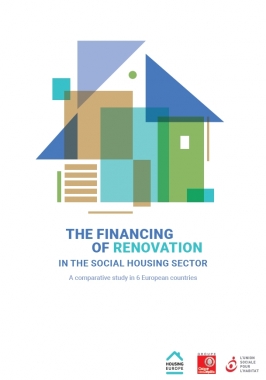The renovation of social housing is the most obvious example of how environment and social justice considerations can be combined. Making renovation affordable for low-income social housing residents is the key question for social housing providers. Housing Europe has put together a unique comparative study in 6 European countries commissioned by Caisse des Dépôts et Consignations (CDC) and Union Sociale pour l’Habitat (USH) presenting what financial frameworks, policies and measures are in place to support the renovation of social, cooperative and public housing in the sample of countries. The study is available in English and French.
Introduction
If one wants to have a short look back at how the European policymakers have dealt with the topic of renovation of housing over the last few years, 2010 would probably be a turning point. That year, on the one hand, the Global Financial Crisis and the various attempts to launch economic recovery plans at the EU and national level effectively put the housing sector and in particular the renovation of the existing stock at the centre of political concern because of its growth-enhancing role. On the other hand, the European Directive on Energy Performance of Building was adopted and it paved the way for more energy efficient new dwellings as well as set the incentives for the renovation of existing dwellings. Almost 6 years on, the role of renovation of existing buildings has been even more stressed by a wide range of stakeholders and policymakers, referring in particular to the Paris Climate Agreement and its translation at the EU level. In a recent publication, the EU Joint Research Centre called energy renovation the “trump card for the new start for Europe”. Furthermore, the European Commission published in December 2016 a set of new proposals on how to step up the renovation of the building stock as a way to meet the EU climate targets.
There is therefore a clear consensus about the important role of housing retrofitting in meeting the climate objectives that have been collectively agreed in order to halt global warming. However, there is a lack of detailed understanding about the drivers for energy renovation, despite a vast number of recent EU projects and reports. The variety of national financial and regulatory frameworks applicable to renovation of housing is one of the reasons why it is difficult to have clear comparative view as well as clear policy recommendations at the EU level.
The present study aims at addressing this lack of precise understanding and will focus on and compare the financing schemes supporting the renovation of social housing in 6 countries. The social housing segment is indeed particularly relevant for policy makers: although social housing, cooperative and public housing make on average only 11% of the housing stock of the EU countries, as this study will show, their energy performance is on average better than the private rental or the homeowners sectors, the expertise of social housing providers in renovation activities is growing in strong and it is the segment who cater for low-income families, people with special housing needs and more generally speaking people who can’t find a decent and affordable accommodation on the private rental market or through access homeownership. This is, therefore, a key segment of the housing market and a key area of intervention of national and regional housing policies.
The renovation of social housing is the most obvious example of how environment and social justice considerations can be combined. Making renovation affordable for low-income social housing residents is the key question for social housing providers.
In this context, the cost of renovation and the various schemes and mechanisms to finance it are determining factors. Bringing down the cost of renovation and, at the same time, the cost of finance are the challenges housing providers are confronted with. The regulatory and financial frameworks in the different countries can either help or on hamper the search for such cost-efficient investments.
The study looked at what financial frameworks, policies and measures are in place to support the renovation of social, cooperative and public housing (hereafter referred to as “social housing”) in the sample of countries.
In the following parts, we will present the result of a survey conducted among providers of social housing in 6 countries: Austria (GbV), France (USH), Germany (GdW), Sweden (SABO), the Netherlands (AEDES) and England (NHF). Those countries have been chosen because of the importance of the social housing stock in terms of the proportion of the total housing stock as well as due to the experience of social housing providers in the renovation activities. Therefore, the figures and information below relate to the social housing sector except in England where it refers to the general housing sector and in Germany, where the figures refer to GdW companies which, while encompassing almost the entire social housing sector, are also housing cooperatives and private rental companies.
After presenting the result country by country, we will present a comparison in a synthetic manner and we will eventually conclude by a set of policy observations aimed at enriching the current policy debate about the role of housing retrofitting to meet the EU climate objectives.
This study has been commissioned by Caisse des Dépôts et Consignations (CDC) and Union Sociale pour l’Habitat (USH)..
